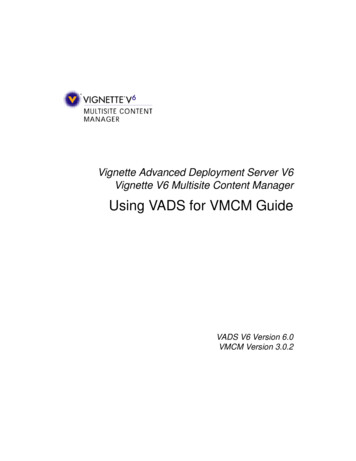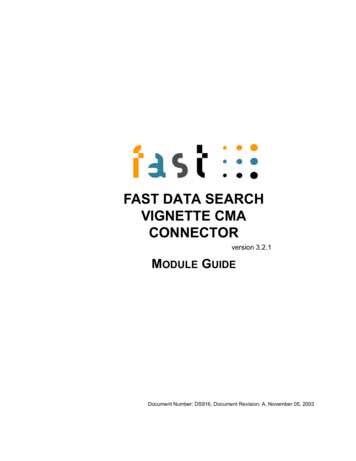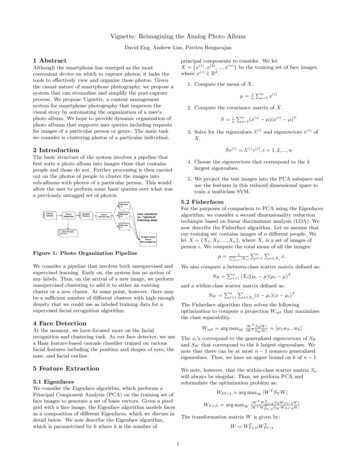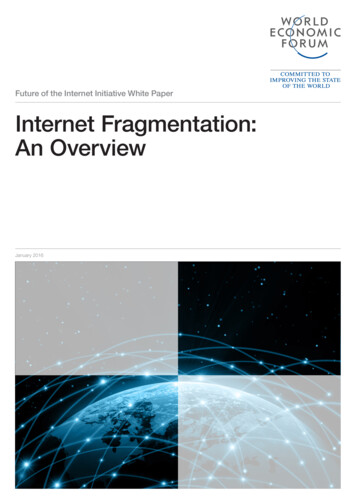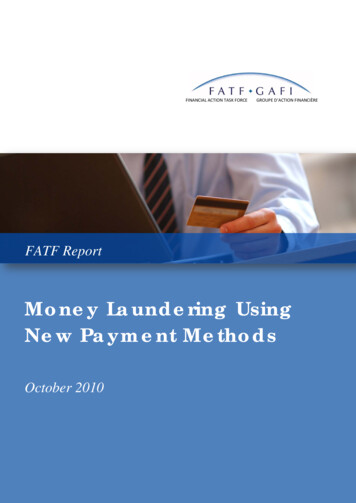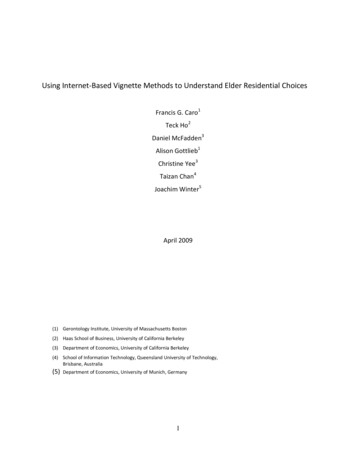
Transcription
Using Internet‐Based Vignette Methods to Understand Elder Residential ChoicesFrancis G. Caro1Teck Ho2Daniel McFadden3Alison Gottlieb1Christine Yee3Taizan Chan4Joachim Winter5April 2009(1) Gerontology Institute, University of Massachusetts Boston(2) Haas School of Business, University of California Berkeley(3) Department of Economics, University of California Berkeley(4) School of Information Technology, Queensland University of Technology,Brisbane, Australia(5)Department of Economics, University of Munich, Germany1
AbstractThis paper illustrates an innovative method of administering fractional factorial surveys(vignettes) using the internet. The approach makes it possible to use video clips to deliverinformation. The method also provides subjects with interactive options before makingjudgments. A study to determine the views of older people regarding residential options is usedto illustrate the method. The study found that the following characteristics of vignette personsaffected subject recommendations: personal introduction, functional status, social network,and current housing characteristics. However, characteristics of retirement community featuresand personal financial status did not affect recommendations.2
INTRODUCTIONBehavioral researchers interested in a wide variety of applications have used vignettesto understand the basis for complex judgments (Green, 1974; Alexander & Becker, 1978). Inmaking decisions, people rarely use a systematic rational planning process through which theyidentify pertinent goals, establish priorities, and weigh evidence on the extent to which variousoptions are likely to enable them to maximize their objectives. More often, people makejudgments quickly with limited insights about the ways in which they were influenced by theinformation that was available to them. Vignettes are among the techniques used by social andbehavioral scientists to understand the basis for human judgments. When used in surveys,vignettes are hypothetical situations presented to respondents to obtain an opinion aboutdesirable or anticipated behavior. The premise in use of vignettes in surveys is that responsesto hypothetical choices provide insights about behavior in real choice situations. A furtherpremise is that hypothetical choices may be revealing in ways that are different from and morerevealing than respondent opinions about abstract principles. Vignette methods are often usedwhen it is not practical or feasible to study actual behavior. Vignettes in surveys represent aninexpensive technique for approximating the use of experiments to study behavior. A variety ofnames is used to identify vignette survey techniques: conjoint analysis, contingent evaluationmethod, fractional factorial survey, and stated choice methods. The differences in terminologyreflect the fact that vignette methods have been developed independently in a number ofdisciplines. Topics frequently studied using vignette methods include: market research onproduct preferences, empirical studies of ethics, the bases upon which professionals such ashealth care providers form diagnostic opinions and treatment recommendations, and thenormative basis for public policy.Cavanaugh and Fritzsche (1985) make a useful distinction between two types ofvignettes used in surveys: constant variable value vignettes (CVVV) and contrastive vignettetechniques (CVT). When the CVVV approach is used, all subjects are asked to respond toidentical vignette content. When CVT methods are used, the vignette structure is systematicallymanipulated so that subjects are asked to respond to somewhat different vignette content. In3
the CVT approach, researchers examine the ways in which vignette structure influenceresponses. Studies that use the CVVV approach are easier to design and administer than thoseusing CVT methods. However, studies employing CVT methods offer analytic possibilities thatfar exceed what is possible with data collected with CVVV methods. The current paper isfocused entirely on use of contrastive techniques (CVT).The purpose of this paper is to illustrate an innovative use of the internet to administersurveys that include vignettes based on contrastive techniques. Use of the internet makes itpossible to overcome some of the disadvantages associated with other means of administeringsurveys using vignettes with CVT features. In traditional surveys with complex vignette content,it is desirable for respondents to be able to read vignette content. This necessitates productionof printed questionnaires that vary from one another because of variations in vignettestructure. Coding systems need to record both respondent choices and the characteristics ofthe vignettes rated by respondents. Computer‐assisted telephone interview protocols make itpossible to avoid the printing of questionnaires and to assure that vignette characteristics areas accurately recorded as subject responses. However, Computer Assisted TelephoneInterviewing (CATI) systems typically do not provide a printed vignette that a respondent canread independently.Major advantages of use of the internet for general survey administration have beendocumented elsewhere (Dillman, Smyth, & Christian, 2008). The internet makes it possible formany respondents who are separated geographically to see a questionnaire simultaneously.Responses can be recorded promptly. Data entry is eliminated as a separate step in theresearch process since subject responses are added immediately to an electronic data file.In the research reported here, the internet is used also to deliver information includingvignette content to subjects through video and audio clips. Use of video and audio clipsprovides a means of engaging subjects more fully than is possible with written informationalone. Videos have previously been used successfully in delivering vignette content.Arber, McKinlay, Adams, Marceau, Link, & O'Donnell (2006) studied primary care doctors whoviewed a video‐vignette of a scripted consultation where the patient presented standardizedsymptoms of coronary heart disease. Videotapes were identical apart from varying patients'4
gender, age (55 versus 75), class, and race. The study showed that the gender of the patientsignificantly influenced doctors' diagnostic and management activities.Use of video and audio clips to deliver vignette content provides investigators a numberof distinct advantages. First, a video format can be helpful in enlisting interest from the subjectand assisting the subject in identifying with vignette persons. Video can also be helpful inaddressing some of the challenges identified by Wason, Polansky, & Hyman (2002) in designingvignette content. These challenges include making the vignettes believable, making themanipulated variables obvious, and guarding against framing effects. Use of video to deliverinformation provides investigators with a way to achieve a good balance between making themanipulated variables clear to subjects and minimizing the risks of framing effects.Further, the internet provides opportunities for investigators to make interactiveoptions available to subjects before they make judgments. In real world choice situations,people often have opportunities to seek additional information before they make decisions oncomplex matters. In internet‐based vignette studies, subjects can be given opportunities toseek information beyond that initially provided by investigators. Opportunities to probe foradditional information can be helpful in sustaining the interest of research subjects. Further,investigators can record the extent to which respondents took advantage of opportunities toseek additional information. In addition, investigators can record the amount of time taken bysubjects in responding to vignette content. For investigators, it is useful to know how thequantity and kind of information considered influence the judgments made by subjects.In this paper, we describe a study that illustrates the use of this methodology. The studywas concerned with the basis on which older people who live in their own homes makeresidential choices when they are confronted with health and disability challenges. Most olderpeople in the United States live in homes that they own and have occupied for many years(Woodward & Damon, 2000). Characteristically, older people are attached to their homes andare reluctant to move (Mutchler & Burr, 2003). At the same time, there often are forces at playsuch as declining health and the death of a spouse that provide older people with reason tomove to a more supportive residential environment (Walters, 2000). Both for profit and non‐profit organizations provide a variety of service‐supported residential options for older people.5
Some are described as retirement communities; others are known as assisted living facilities.Residential decision making of older people lends itself to study through use of vignettemethods for a number of reasons: 1) the topic is important to older people and their adultchildren, 2) older people can make but do not necessarily make a residential choice through acareful consideration of options, and 3) older people have reason to consider information on anumber of diverse dimensions in making decisions about residential options. Use of a methodthat permits delivery of information visually is particularly helpful in the case of research onresidential options since information on housing characteristics particularly lends itself to visualpresentation.METHODSWe began the research process by conducting qualitative interviews on residentialoptions with an opportunity sample of 34 older people (Gottlieb, Sauder, & Caro, 2009).Volunteer subjects were recruited from among older people who were either enrolled in thelearning‐in‐retirement program or who were active as volunteers at the Gerontology Instituteat the University of Massachusetts Boston. The interviews covered participants’ currentresidential circumstances; residential changes participants had made in response to changinghealth, financial, and personal (marital status, etc.) circumstances; residential steps participantshad undertaken or contemplated to address potential long‐term care issues; and prioritiesregarding residential considerations. Through the qualitative interviews, we gained insightsabout the importance of residential options for older people, the dimensions important toolder people in considering residential options, and the language used by older people indiscussing residential issues.In designing the vignette experiment, we deliberately simplified the situation to bestudied. Simplification was necessary to avoid overwhelming subjects with information andoptions. Subjects were asked to consider only two options: remaining in current housing ormoving to a specific retirement community. Subjects were not asked to consider homemodification as an option. Subjects were also asked not to consider as options a move to aconventional age‐integrated housing or to a nursing home.6
Subjects were asked to consider the situations of hypothetical vignette persons withwhom they could identify. Our premise is that subject‐recommended actions for vignettepersons would provide insights about what subjects would do themselves if confronted by asimilar situation. We work within the premise articulated by Peter Rossi that members of asociety embrace common social norms; accordingly, the opinions of a sample provide a basisfor understanding the norms that prevail within the society (Rossi & Anderson, 1982).We deliberately considered only the circumstances of older people whose spouses haddied. Accidently, we also considered only the situations of widows. We created a vignettescenario using a framework proposed by Rossi & Anderson (1982) in which a distinction is madeamong dimensions, levels, objects, judgments, and the factorial object universe. Dimensionsare social objects that can vary qualitatively or quantitatively. Levels are the specific values thata dimension may take. Objects are units being judged that are described by a single level foreach dimension. A judgment is the rating given by a respondent to an object. The factorialobject universe is the set of all unique objects formed by all possible combinations of one levelfrom each of the dimensions (i.e., the product of all of the levels).In the study described here, we included five substantive dimensions with levels thatvaried from two to four: 1) functional status (3 levels), 2) social network (3 levels), 3) currenthousing (2 levels), 4) retirement community characteristics (2 levels), and 5) financialconsiderations (4 levels). We also included two supplementary dimensions: a substantiveintroduction and introductions by vignette persons. To establish a substantive context for theresearch, subjects watched and listened to a video clip in which a mature man spoke about therelative merits for older people staying in their homes or moving to a retirement community. Inone case, the man introduced himself as a doctor. In the other case, the man introducedhimself only by his first name. Although the introduction was intended to be balanced, wewanted to see whether the identity of the host would have an influence on respondents’judgments. Each of the four vignettes that subjects were asked to rate was introduced by avideo clip of a different woman (Jean [age 76], Alice [age 75], Dorothea [age 77], and Lois [age75]). Each of the women provided similar information; that is, each was a widow, attracted toremaining in her home, experiencing health problems, and considering moving to a retirement7
community or assisted living facility. However, the women were different in their appearances.The settings in which the women were filmed also differed. We wanted subjects to be able toidentify with the vignette persons. Because of the possibility that subjects would identify withthe vignette persons in different ways, we considered the identities of vignette persons to bedimensions for analytic purposes. The vignette structure is shown in Table 1. Considering onlythe substantive variables, the factorial object universe was 144. With the addition of thesupplementary dimensions, the factorial object universe was 1152.TABLE 1 (Back of report)We provided interactive options on four of the five dimensions. On the functional statusdimension, subjects could request the recommendation of a visiting nurse. On the currenthousing dimension, subjects could request: 1) a video clip showing generic features of“challenging” or “elder‐friendly” homes, 2) a list of challenging or elder‐friendly home features,3) photographs of a few features of the homes of vignette persons such as bathrooms andinterior stairs. On the retirement community dimension, subjects could request: 1) a video clipshowing generic features of “popular” and “up‐scale” retirement communities, 2) lists offeatures of the retirement community that the vignette person was considering, and 3) a fewphotographs of the specific retirement community that the vignette person was considering.On the financial dimension, subjects could request a chart showing detailed expenses if theyremained in their homes or moved to retirement communities. They could also ask to see therecommendation of a financial planner. The generic video clips for current housing and theretirement community that was considered always corresponded to the level that subjectswere considering. In other words, when the vignette person lived in a “challenging” home,subjects had the option to see the video clip describing a challenging home. When the vignetteperson lived in an “elder‐friendly” home, the video clip describing that home was available.Much of the detail of the vignette scenario is shown in the appendix. Included in the appendixare the instructions to subjects, examples of a functional status level, a nurse’srecommendation, and a current housing level. Following are lists of features of a house that issafe for an older person and characteristics of a housing that is challenging for an older person.These lists are followed by examples of a retirement community option, the wording of a8
financial dimension condition, a financial planner’s recommendation, and a table showingfinancial details. The appendix concluded with the wording of the choice options.For each vignette, subjects were asked whether they would recommend that thevignette person either remain in her current home or move to the retirement community. Theywere also asked to rate their confidence in their choice on a 10‐point scale anchored by “justguessing” and “absolutely sure.” Subjects were also asked what they would do if they were inthe situation of the vignette person. Again, they were asked to rate their confidence in theirchoice. After judging four vignettes, subjects were asked to respond to a questionnaire thatsought background information on type of current housing, interest in a retirement community(among those living in their own homes), year of birth, gender, education, race/ethnicity,marital status, functional status of spouse, income, health, functional status of respondent,driving status, number of children, proximity of children and friends, expectation of leaving abequest, survival expectations, financial concerns, and happiness.Internet Administration of the Survey ProgramThe core design and process flow of the vignette‐approach experiment was captured inweb‐based software. The software was developed and tested extensively on various operatingplatforms, browser versions, and with users of different technical expertise. The softwareconsists not only of the components with which subjects or respondents interact; it also has anadministrator control panel that gives the organization conducting the experiment the ability tomanage, monitor, and control the administration of the experiment.The software employs standard cascading style sheets and browser‐sensitive client‐sideJavaScript to ensure a consistent look‐and‐feel across the experiment and maximumcompatibility with the various browser versions and operating system platforms.The software is supported by an MSSQL databases and structures with predefined viewsand procedures to ensure optimal response time and data management.Data CollectionOlder people were challenging subjects for a study that sought to develop new methodsfor web‐based vignettes to subjects. Many older people have limited skills using computers forinternet access. Because we sought to include subjects with little skill using computers, we used9
data collection techniques that would not have been necessary with internet‐proficientsubjects.The survey was administered to older people enrolled in a learning‐in‐retirementprogram at the University of Massachusetts Boston and in five senior centers in Bostonsuburbs. The suburbs selected for subject recruitment have above‐average income levels withhigh rates of home ownership. In the learning‐in‐retirement program, research assistants wentto classes where they made brief oral presentations and asked for volunteers. Those enrolled inclasses were given handouts describing the study. In the senior centers, the study wasdescribed in newsletters that were mailed to homes of older residents. Interested persons wereinvited to call to make an appointment. Research assistants also recruited subjects byapproaching seniors present at the senior centers.In most cases, subjects used computers at the university or at a senior center. In thesesettings, a research assistant was present to provide instructions. Subjects who were skilled inuse of computers typically needed help only with getting started with the survey process.Often, subjects needed help at the outset in navigating screens and in recognizing interactiveoptions. A few subjects with no experience using a mouse needed help throughout the process.Subjects recruited in senior centers tended to be a few ye
vignette content to subjects through video and audio clips. Use of video and audio clips provides a means of engaging subjects more fully than is possible with written information alone. Videos have previously been used succ
